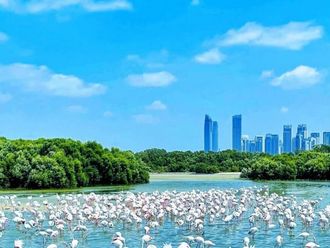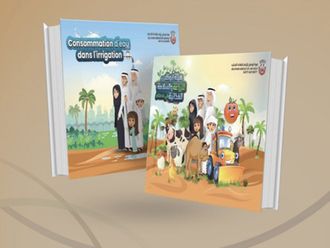
Abu Dhabi: If you visit a zoo during the daytime in the summer, chances are you won’t be able to see any tigers or leopards.
“They will be hiding somewhere; lying idle during the daytime. Being inactive is their natural defence mechanism to cope with the summer heat,” says Dr Mohammad Sa’ad, Animal Health Manager at Emirates Park Zoo in Abu Dhabi.
But they will be active in the morning and evening.
As the summer is reaching its peak in the UAE and people are taking precautions to beat the rising the mercury, Gulf News checked with two zoos in Abu Dhabi to find out how wild animals cope with the season.
The wide enclosures that house big cats have an air conditioned service area, where food is served and they can rest. Most of them stay in the service area during the day.
When the Gulf News team visited the zoo last week, they could not see the tigers inside their enclosures even after waiting for long. Finally, a white tiger was spotted sleeping inside the cage.
But cheetahs are more active despite the heat.
“They wake up and walk if they are hungry during the daytime. He is hungry and his caretaker will give him the food soon,” Dr Sa’ad said.
Tigers and cheetahs need a cool environment because their natural habitat is thick forest.
“They live inside the jungle that gives them enough shade and cooling,” said Dr Sa’ad, who worked at Al Ain Zoo for 20 years as a veterinary doctor.
Generally, all carnivorous animals find it difficult to cope with heat but lions are an exception.
Lions are used to hot weather as their natural habitat is grassy plains, savannas, open woodlands, dry thorn forests in Asia and semi-arid plains of sub-Sahara Africa.
There is constant water flow inside the enclosures of all big cats. However, the pipes for irrigating the grass and bushes inside the enclosures have been installed on the steel roof. “If pipes are on the ground or underground, they will dig out and destroy them,” Dr Sa’ad said.
Water is frequently sprayed through a computerised system in the animals’ enclosures and on the visitors’ walkways to maintain a cool atmosphere during the daytime.
Racoons, an omnivorous animal, also get special care during the summer. The twelve racoons at the zoo depend on the refreshing pool inside their air-conditioned enclosure to keep cool.
Most of the animals in enclosures without a roof, such as blackbucks from India and a group of scimitar-horned oryx, take shelter from the sun under newly added shades made of palm leaves.
Now extinct in the wild, scimitar-horned oryx once lived in north African countries such as Egypt, Senegal, and Chad. Both male and female have curved horns that grow up to several feet long. They are mostly white with reddish brown necks and marks on the face and a long, dark, tufted tail. The white coat helps them reflect the heat of the desert.












